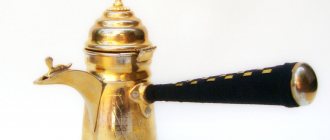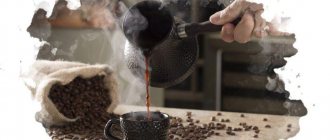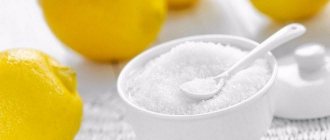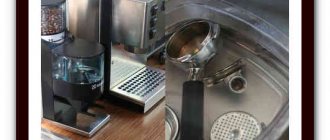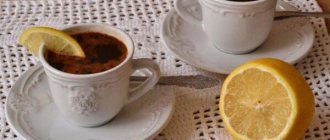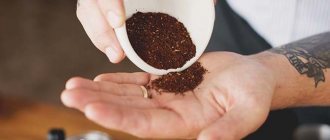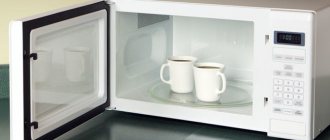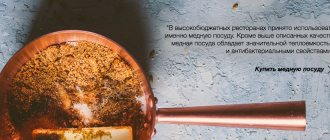Choose wisely
Turka or cezve is a special vessel in which you can prepare natural aromatic coffee. Its feature is a wide bottom and a narrow neck. This shape helps preserve the aroma of the coffee beans, and the thicker contents settle to the bottom faster.
Professionals recommend buying cookware made of copper, as it ensures uniform heating of the liquid and complete extraction of coffee oils.
Additional selection criteria:
- the diameter of the neck is 2-3 times smaller than the bottom;
- wall thickness – 1.5 mm;
- the handle is long, located at an angle;
- volume – 100-150 ml.
Find out more in the article “How to choose the right copper Turk”.
Rules for caring for copper cookware
Take care of your cezve regularly to maintain its presentable appearance and extend its service life.
Rules of care:
- The Turk should be washed immediately after use and separately from other dishes.
- Use water for washing and rinsing at the same temperature.
- Always wipe the coffee pot dry.
- Periodically polish the top surface with a woolen cloth.
- Store the cezve in a dry place; at a humidity of 50% or higher, copper oxidizes.
Do you follow all the rules of care?
Not really
List and features of cleaning products
It is important
To return your dishes to their original appearance, read the recommendations on how to clean a copper pot so as not to damage it. Not all products are suitable for this procedure.
You can remove dirt with special detergents for copper: Starwax, Gipfel, Magic Power, Stellar kitchen.
Traditional methods are also suitable, the characteristics of which are given below.
Before the procedure, determine the reaction of copper to the selected component. Treat a small area of the surface of the Turka. If nothing happens after 15-20 minutes, use the product without fear.
Citric acid or lemon juice
To remove stains from the outer surface of the cezve, you can use both components.
Prepare a working solution of citric acid in the following proportion: 2 tsp. products for 250 ml of water. Apply evenly to darkened areas.
Cut the lemon in half, sprinkle the halves with fine salt and clean the problem areas.
Expert opinion
Vadim Kudryavtsev
Coffee expert, professional barista and simply in love with this aromatic drink.
Ask the barista a question
The method will help remove dark areas, but if copper comes into contact with acid or juice for a long time, it will have the opposite effect. Therefore, after the procedure, thoroughly rinse off any remaining substances.
Vinegar and table salt
You cannot use vinegar in its pure form - this will lead to oxidation of the metal. Therefore, to clean the cezve, prepare a dough based on this component.
Combine 2 tbsp. l. wheat flour and 50 ml of 9-15% vinegar. The consistency of the dough should be uniform. To avoid burning your hands, wear rubber gloves.
Use finely ground salt to remove stains. Large particles will scratch the metal. For severe stains, combine this component with vinegar in a 3:1 ratio.
Baking soda
To return the copper surface to a presentable appearance and get rid of coffee residues if it is burnt, boil the coffee pot in a soda solution.
To do this, dissolve 30 g of the cleaning component in 1 liter of water. Pour the solution into a deep container so that it covers the cezve and place on fire. Boil for 1.5 hours. The method is long, but removes dirt well.
Interesting! How to prepare coffee beans correctly
Ammonia
When working with ammonia, follow safety precautions - wear rubber gloves and a mask. Otherwise, you will be burned by the liquid or inhale it.
Ammonia removes old and stubborn stains. Before cleaning, prepare a solution: dilute ammonia with water in a ratio of 1:2.
After the procedure, wash off the alcohol from the surface of the cezve with warm soapy water. Otherwise it will bind oxide and contaminants. This will make further cleaning more difficult.
Vegetable brine and tomato paste
100 g of tomatoes contain 25 mg of ascorbic acid. It will help quickly remove plaque from the copper surface. You can use fresh tomatoes or ketchup based on them.
Apply the paste to problem areas and rub. Cheap ketchup, even expired ones, will do the job better.
Cabbage or cucumber pickle is suitable for removing dark spots. If there is only a little liquid, soak a cloth in it and wipe the copper surface. If there is enough brine, immerse the cezve in it and wait 7-10 minutes.
Milk serum
25% lactic acid, which is found in dairy products, helps clean the internal and external surfaces of the cezve.
Take a deep container, pour the whey into it and heat it to a temperature of 40-50 degrees. Immerse the coffee pot in the liquid for half an hour. During this time, the dark spots will disappear.
Toothpaste and powder
If you use toothpaste, choose a brand that does not contain large abrasive particles: REMBRANDT, PRESIDENT Activ, SPLAT Extreme White, Bionics, Forest Balm.
Abrasives scratch the surface of the Turk and spoil the appearance. To remove stains, apply the component to the brush and wipe the problem areas.
Using tooth powder is a dry cleaning method. Apply the component to a napkin and clean the surface with intense circular movements. Then rinse and wipe the bowl dry.
A similar procedure can be carried out with chalk and flour.
How to clean the outside of a copper pot?
The most popular and affordable home remedies for the acid cleaning method are:
- Lemon and citric acid.
- Vinegar.
- Ammonia.
- Brine.
- Milk serum.
- Ketchup.
Important! Do not use extreme acidic cleaning products such as oxalic or hydrochloric acid. Avoid handling such strong drugs, especially if you do not have the necessary experience.
The following soft abrasives are suitable for the abrasive method:
- Crushed chalk.
- Wholemeal flour.
- Talc and sawdust.
- Soda.
- Paste GOI.
Important! All soft abrasives are used in the same way: apply the product to a flannel cloth and polish the surface of the cookware in a circular motion. After the cleaning procedure, rinse the product and wipe dry.
We offer you several time-tested methods for cleaning copper cookware using available materials.
Lemon
Dishes that have become blackened over time can be easily cleaned using lemon, and in more than one way.
Option 1
Proceed as follows:
- Cut the lemon into 2 parts.
- Rub the dry Turk over the entire surface with lemon. For a better effect, half a citrus fruit can be sprinkled with fine salt.
- Leave the dishes for a couple of minutes.
- Gently rub the lemon juice over the surface with a brush.
- Rinse off the product under running water.
- Wipe the surface thoroughly with a linen cloth.
- Polish the product with a soft cloth.
Option 2
Fresh lemon can be replaced with a solution of citric acid. Dilute 2 teaspoons of acid in 200 ml of warm water. Clean the outer surface of the Turk with the solution. Afterwards, rinse the dishes and dry thoroughly.
Important! Do not leave the Turk in the lemon solution for a long time, as the acid can form dark spots on the copper with prolonged exposure.
Option 3
You can clean copper using lemon juice and fine salt. Squeeze the juice of one lemon and add salt until it forms a mushy consistency. Use a soft sponge and mixture to clean the surface of the Turk. Rinse the product with warm water and wipe with a soft cloth.
Vinegar
You can also clean the outside of a copper pot at home using this product in different ways.
Option 1
You can remove dark deposits from a coffee pot using a vinegar and salt scrub:
- Add 2 tbsp to a tablespoon of salt. spoons of vinegar.
- Apply the scrub to the surface of the dishes with a soft cloth.
- Rub the product in a circular motion onto the surface.
- Treat the relief designs on the Turk with a toothbrush.
- Rinse the Turk with warm water.
- Wipe the product dry with a soft cloth and polish.
Option 2
If a dark spot appears on a copper item, boil the item in a weak solution of vinegar and salt:
- Pour 1 glass of vinegar into a deep saucepan and add 1 tbsp. spoon of salt.
- Fill the ingredients with water and place the Turk in the solution.
- Place the container on the stove and turn on the heat.
- Bring the water to a boil.
- Boil the product until the oxides dissolve (10-30 minutes).
- Take the product out and let it cool.
- Wash the Turk with soap and running water and wipe dry.
Option 3
You can clean a copper pot using vinegar and a mixture of sawdust and talc:
- Mix sawdust with talcum powder in a 2:1 ratio and dilute the mixture with vinegar to a paste consistency.
- Apply the product to the surface of the Turk using a sponge.
- Wait until completely dry, polish with a dry cloth.
Important! When working with vinegar, protect your hands with gloves to prevent the acid from irritating your skin.
Option 4
To avoid excessive oxidation of the metal by acid, use the old vinegar test recipe:
- Mix 1 tbsp. a spoonful of salt and 1 glass of vinegar.
- Gradually add flour to the mixture until a mushy consistency forms.
- Apply the prepared paste to the dirty areas of the dishes.
- Leave the Turk until dry (15-40 minutes).
- Scrub the paste thoroughly with a dry brush—you can use an old toothbrush.
- Rinse the dishes and wipe dry.
Important! Vinegar dough is effective for Turks that are engraved or embossed, as it removes dirt well in the most inaccessible recesses.
Milk serum
This method has helped our grandmothers out more than once, and it is still relevant today.
Instructions for use:
- Dissolve 1 tbsp in 1 glass of whey. a spoonful of table salt.
- Apply the mixture to a flannel napkin.
- Clean the surface thoroughly with a damp cloth.
- Cover heavily soiled areas with a napkin and leave for 3-4 minutes.
- Wipe the entire surface of the dishes again.
- Rinse the Turk with warm water.
- Dry thoroughly and polish with a soft cloth.
Important! For the solution, it is better to take finely or medium-ground salt so that it dissolves well. Make sure that no insoluble salt grains remain on the napkin, which can spoil the surface.
Ketchup
The product contains citric acid and tomato paste, rich in natural acids. Therefore, if there is ketchup left in the refrigerator, use it to clean the copper pot:
- Squeeze a little product into a deep bowl.
- Dip the copper product in tomato ketchup.
- Soak the item in ketchup for 10 minutes.
- Clean the product with a sponge or cloth.
- Remove the item and rinse off the ketchup with warm running water.
- Wipe dry and polish with a soft cloth.
Important! Use the cheapest ketchup available. You can also use a product that has expired. Ketchup will not only clean the Turk, but also restore its bright, copper color.
Brine
You can use any brine for the procedure - from sauerkraut, cucumbers:
- Apply the brine to the dishes and leave for 3 minutes.
- Rinse off the product with warm water and wipe the product dry.
Ammonia
Ammonia is a very active chemical compound, so you need to work with it very carefully, not forgetting about safety measures. Ammonia is perfect for removing deep and long-standing stains and combating green stains.
Option 1:
- Dilute ammonia with water in a ratio of 1:2.
- Dampen a napkin with the solution.
- Wipe the outer surface of the dish with a napkin.
- Wash the Turk with warm water and soap.
- Dry the dishes with a soft cloth.
Option 2:
- To clean brown deposits on copper, immerse the product in a solution of ammonia for 2 minutes.
- Then rinse off the deposit with water and wipe the product.
Important! When working with this tool, keep these tips in mind:
- Be sure to wash off ammonia with warm water and soap, as ammonia binds oxidation products and contaminants, forming an ammonia complex.
- Work with ammonia only in a well-ventilated area and wearing gloves, as ammonia is very dangerous and has a pungent odor.
Option 3
You can tidy up copper utensils using a mixture of ammonia, crushed chalk and water:
- Mix the ingredients in a ratio of 3:1:6.
- Shake the mixture well.
- Apply the solution to the surface of the dishes using a sponge.
- Carefully clean the surface of any dirt.
- Rinse off any remaining product with warm water.
- Wipe the product thoroughly and polish.
Important! All of the above cleaning methods should be used only after preliminary testing on a small surface of the product in order to determine the nature of the reaction of copper to the product. If no change occurs, apply the cleaner to the entire surface of the item.
What not to use
We found out how to clean a copper Turk outside and inside. Now let's talk about what you should not use to clean copper.
It is prohibited to use hydrochloric and sulfuric acid. When reacting with oxygen and acids, copper begins to dissolve. Therefore, avoid products that contain these components.
Interesting! How to make a latte in a coffee machine
When using the dry cleaning method, do not use powders that contain large abrasive particles. They scratch the surface of the Turks.
How to clean copper cookware at home?
How to wash a Turk from burnt coffee and scale? To return a copper product to its original shine and excellent appearance, you can use two main types of cleaning:
- Acid.
- Abrasive.
There are time-tested products for each type of cleaning. Today we will talk not only about general methods for cleaning copper objects, but also share tips on caring for a Turk.
If you regularly use a Turk to make coffee, then you often have to remove accumulated dirt from its surface. Inside there is a coffee residue, and outside there is soot from the flame of a gas stove. And if deposits on the outer surface do not spoil the taste of coffee, then internal deposits can change the smell of the drink. Next, we will tell you how to clean a copper Turk both inside and out while maintaining the integrity of the coating.
How to clean a Turk
How to prepare dishes
There is no need to specially prepare the Turk for cleaning. Simply rinse off the coffee residue, rinse the dishes and wipe dry. Take the appropriate product and start cleaning.
Remember the safety precautions when using vinegar and ammonia, which are described above.
Cleaning from the inside
When making a cezve, the inside is coated with a special layer to prevent copper particles from getting into the drink. Tin is most often used for this. Clean the Turk carefully so as not to disturb the protective layer.
Algorithm of actions for the wet cleaning method:
- Prepare a deep container to immerse the Turk in it.
- Fill it with a solution of vinegar, baking soda, table salt, citric acid, brine, and whey.
- Immerse the copper bowl in the liquid.
- Boil for 1.5 hours, add solution as it evaporates.
- Remove the container from the heat and cool.
- Take a brush that fits through the narrow neck of the cezve and wipe the inside surface.
- Remove the coffee pot from the container, rinse with warm water, and wipe with a dry soft cloth until it shines.
For the dry method, apply the powder to a soft-bristled brush and wipe the inside of the Turk. Do this until the plaque disappears. Wipe with a paper towel.
Cleaning Copper Coins
Coins made of copper are no longer issued in our time, and many such products in the hands of the population are of antique value. That is why the question of how to effectively and at the same time carefully clean such coins is quite relevant.
You can restore the former attractiveness of copper coins using several methods. The choice of each of them depends on the nature and degree of contamination. So, depending on what color the plaque has formed on the surface of the old copper coin, you can clean it using one of the methods listed below.
- If there is a yellowish coating on the surface of the coin (this indicates that it has been in contact with a lead product), then it should be cleaned with a 9% vinegar solution.
- Clearly green plaque is cleaned with a 10% citric acid solution.
- Coins made from copper may also have a reddish coating. Such a coin is cleaned by dipping it in a 5% ammonia solution or ammonium carbonate.
Calculate the use of chemicals depending on the degree of contamination
Old coins made from copper may have a layer of patina, which gives them a more noble and aged appearance. If there is no such plaque, you can create it yourself, even at home. To do this, use a solution consisting of a liter of distilled water, 50 grams of copper sulfate and 5 grams of potassium permanganate. The resulting solution is heated over low heat, without bringing it to a boil, and then coins are placed in it, which must be covered with a layer of patina. They are periodically turned over, and when the color of their surface acquires the desired shade, they are removed. To consolidate the effect obtained, the surface of completely dried coins can be treated with benzene and alcohol mixed in equal proportions.
Source
